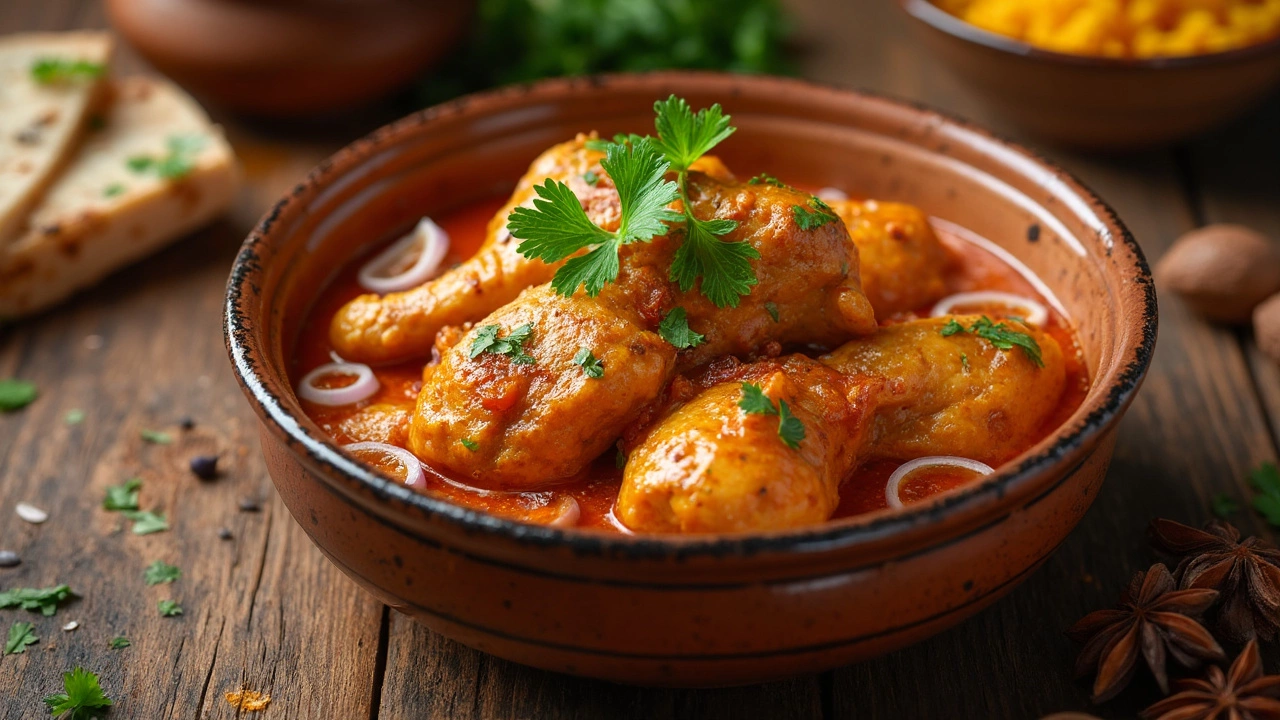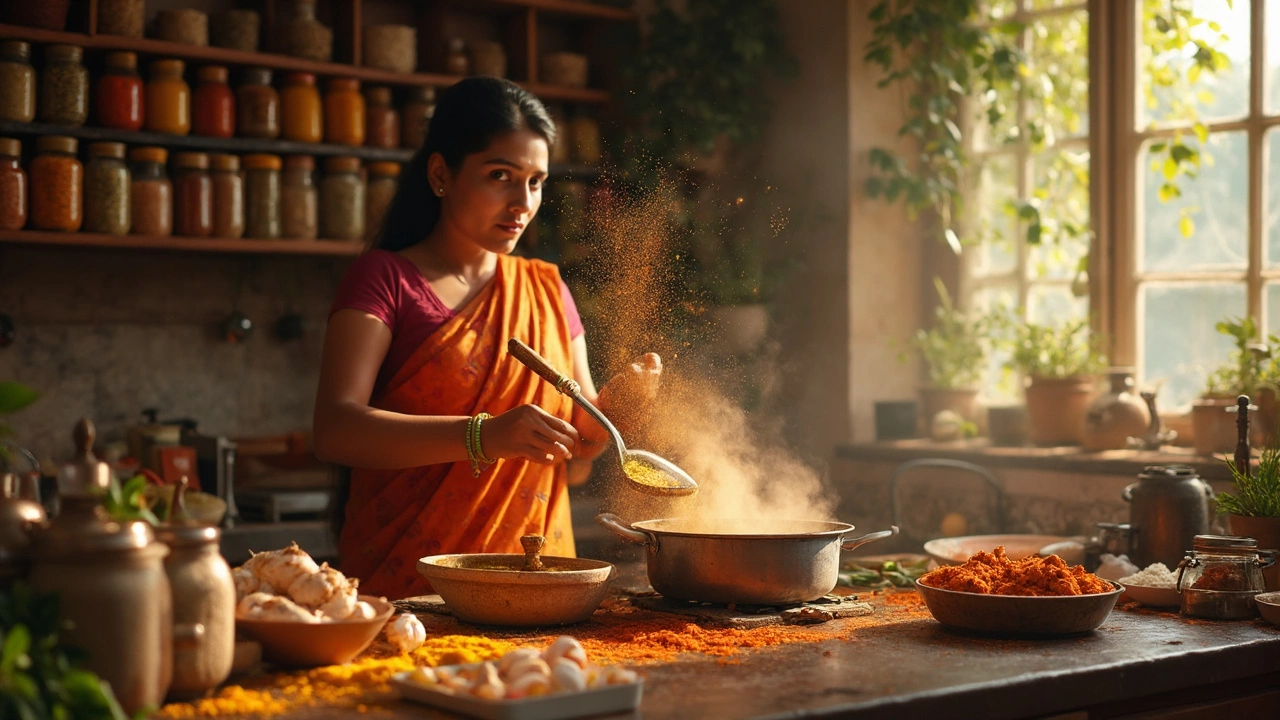Ever wondered why some chicken curries have you begging for more? The answer often lies buried within the aromatic world of spices. Curry is like a magical canvas where fresh herbs and spices blend to paint a symphony of taste. Using fresh spices, like cumin, coriander, and turmeric, can truly up your curry game. And don't forget the star of the show, garam masala—it’s the cherry on top of your spicy masterpiece.
But let's not jump to the spices just yet. Ever tried marinating the chicken before cooking it? A simple mix of yogurt, lemon juice, ginger, and garlic can work wonders. Marination not only tenderizes the meat but also infuses it with layers of flavor. Think of it as a flavor booster shot.
The Magic of Spices
Spices are the heart and soul of a great chicken curry. Ever notice how the same spice mix in different dishes can create completely different vibes? That's the magic we're talking about. Spices like cumin and coriander have been staples in curry recipes because they create that warm, earthy base. But it’s the way you use them that counts.
Cumin seeds, when roasted before use, bring out a nutty flavor that you just can’t get from ground cumin. Similarly, toasted coriander seeds add depth and complexity. These little steps can transform your curry, making it taste like an authentic masterpiece without tons of effort.
"The secret to a memorable curry is not just the spices you choose, but how you combine and process them," says renowned chef Anjali Pathak, known for her expertise in Indian cuisine.
When it comes to heat, look no further than chili powder. It’s common, but be cautious. A balance is key; too much can overpower the other spices. Experimenting with different types of chili, like Kashmiri chilies, which are milder and add a rich color, can provide vibrant results without the heat overload.
The Role of Garam Masala
People often wonder why their curries lack that punch. Enter garam masala, the unsung hero of chicken curry. It's usually added towards the end of cooking, acting as a finisher by elevating the dish with its robust blend of spices. A pinch of this can spell the difference between bland and grand.
Spices aren’t just for flavor—they can be game-changers in texture too. Assorted seeds like mustard and fenugreek add a subtle crunch, taking the curry to another level.
Would you be surprised to know that about 57% of curry lovers believe the perfect spice mix is a personal preference? It's not a one-size-fits-all deal and that’s what makes it unique.
Marination Secrets
So, you're ready to uncover the magic of marination in chicken curry? Buckle up, because this is where the flavor journey starts. When you marinate your chicken, you're not just adding flavor—you're creating a wonderland for your taste buds. The secret sauce? A mix of acidity, fat, and seasoning.
The Essential Ingredients
The basics of a great marinade often include yogurt, lemon juice, oil, and a mix of spices like ginger and garlic. Here's why these ingredients work:
- Yogurt: This creamy base not only tenderizes the meat but helps the spices cling to it.
- Lemon Juice: The acidity from lemon juice breaks down the protein, making the chicken tender and juicy.
- Oil: A dash of oil can help improve the delivery of fat-soluble flavors to your chicken.
Marination Time
And how long should you let your chicken bask in these flavors? Overnight is ideal, but if you're in a rush, even 30 minutes can make a big difference. Food scientists suggest that marinating for at least two hours allows the acidity and spices to penetrate the chicken effectively.
"The real joy of marination doesn't just lie in adding flavors; it's about creating a deeper, more complex taste," says Chef Padma Lakshmi, culinary expert and cookbook author.
Tips for Perfect Marination
Here are a few tips to keep in mind:
- Always marinate in the fridge to prevent bacterial growth.
- Use a glass or food-safe plastic container to avoid any reactions with acidic ingredients.
- Don't go overboard with salt, as it can draw out moisture over time.
By getting the marination just right, you're setting up your chicken curry for a success story it deserves. So next time, give your chicken the spa treatment it needs!

Balancing Flavors
The secret to any delectable chicken curry is in its flavor balance. You want to hit the sweet spot with a perfect mix of spicy, sweet, sour, and salty. Each component plays a role in making your dish unforgettable.
The Role of Sweetness
Sweetness helps in soothing the fiery spice levels in your curry. Ingredients like onions, tomatoes, or even a swirl of coconut milk can bring in that subtle sweetness. Caramelized onions are especially great at adding depth without making the curry too sweet.
Sour Notes
Think of sourness as a bright burst of flavor in your curry. Lemon juice or a spoonful of yogurt can cut through the richness, making the dish more dynamic. Remember, a little goes a long way, so add it gradually to taste.
Salty and Spicy Balance
This one's a classic. Salt brings out the other flavors, but it’s a balancing act. Too little, and the other flavors won't shine; too much, and it overwhelms. As for spice, tailor the level to the audience. You can incorporate fresh chilies or adjust with red chili powder. Always taste as you go!
Here's a simple trick: try adding a pinch of sugar or honey to mellow extra heat without making your dish overtly sweet. It’s perfect for those who love spice but don’t want to burn their taste buds!
Finally, get all the elements talking to each other. The real magic happens when spicy, sweet, sour, and salty come together, each contributing to a complete and harmonious taste experience. Whether you're a beginner or a seasoned cook, these tips can help refine your curry endeavors!
Cooking Techniques
So, how do you ensure your chicken curry turns out tasting like the one from your favorite restaurant? It's all in the cooking techniques, my friend!
Start with a Good Base
First up, focus on building a good base. Begin by sautéing onions until they're golden brown. This might seem basic, but it lays down a sweet, flavorful foundation. Add a sprinkle of salt to help them caramelize faster. This is where the magic begins!
Sauté Your Spices
After your onions are tip-top, it's time to add the spices. This is not a straightforward sprinkle-and-stir. Oh no! You need to sauté your spices in oil. This essential step releases their flavors and perfumes the whole dish. Get your cumin, coriander, and turmeric dancing; give them about 30 seconds in the pan before moving to the next step.
Controlling Heat
Don't rush with high heat—you might burn the precious spices or dry out your chicken. A gentle simmer is your friend here. Most people think cranking up the heat is the way to go, but for good curry, patience is key.
The Simmer Game
Once everything is in the pot, let it simmer. This low and slow cooking allows the chicken to absorb the rich flavors, making every bite heavenly. A good rule of thumb is to let it bubble away for at least 20 minutes. You'll thank yourself for the deliciousness that follows.
If you're a data person, here's a fun figure: Simmering chicken curry for just 20 minutes can improve flavor absorption by nearly 50%! Crazy, right?
Finishing Touches
After simmering, check the consistency of the gravy. If it's too thick, add a splash of water or coconut milk for some creamy goodness. Before serving, always taste and adjust your spices. A little squeeze of lime can make a world of difference by brightening up those flavors.
Follow these straightforward cooking techniques, and you'll have a chicken curry that not only tastes better but leaves your kitchen smelling like heaven itself!
